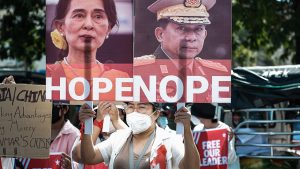More than 1,000 people have been killed by security forces in Myanmar since the military seized power from the elected government of Aung San Suu Kyi about six months ago, a local activist group said yesterday.
Since the military takeover on February 1, the Assistance Association for Political Prisoners (AAPP) has meticulously cataloged those killed by the security forces, updating its database daily. The group said it confirmed two more deaths yesterday and then another five today, bringing the total to 1,006.
The coup plunged Myanmar into turmoil, prompting mass demonstrations and strikes to which the military junta responded with lethal force. While the pace of killings has slowed as protests have fragmented, casualties are rising as armed resistance grows in both urban and rural areas, and the military intensifies its attacks on ethnic armed groups in outlying regions of the country.
The military authorities claim that the AAPP figures, widely cited by international organizations and the foreign press, are exaggerated. But the group claims that if anything its figures are an undercount. “According to AAPP records, 1,001 innocent people have been killed,” the group’s secretary Teik Naing told Reuters. “The actual number of victims is much higher.”
Many of those killed were gunned down during the large protests that took place in the weeks following the coup; others have died in custody or under torture from regime operatives. Members of the security forces have also been killed, especially as instances of local armed resistance grow, but the AAPP does not include them in its count.
Among the rollcall of the martyred was Zaw Tun, 45, who wrote stories and poems while making a living selling cakes and ice cream. “They shoot us in the head,” he wrote on social media shortly before his suspected death by torture in May, “but they don’t know that the revolution is in the heart.” Another was Tin Nwe Yee, a 59-year-old high school math and history teacher, who was killed just months before her planned retirement.
Some, like 19-year-old Kyal Sin, nicknamed Angel, who was shot and killed during a protest in the capital Naypyidaw in early March, have come to personify the sacrifices of the resistance to military rule. When she was killed, Angel was wearing a T-shirt that bore the message, “Everything will be OK,” a phrase that has since become a rallying cry for those opposing the junta.
Unfortunately, the optimism of the motto seems to run counter to the realities of Myanmar’s tortured crisis, to which there seems no quick or easy end.
While the military’s coup remains in many ways incomplete, given the continuing resistance, both armed and passive, of a large percentage of the country’s population, Sen. Gen. Min Aung Hlaing and his cronies have shown little inclination to relinquish the violent tools at their disposal.
One wonders how many more people will lose their lives in pursuit of the Tatmadaw’s fantasia vision of a forcibly unified Myanmar.































